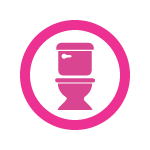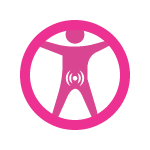So, what are the symptoms?
BPS/IC symptoms can have a mild onset – then typically worsen with time and repeat in cycles that vary from mild to severe. They can improve for a while (usually over a few weeks) before returning to a cyclical pattern. They can also vary from patient to patient and from day to day, but there are three common signs.1,44
 Urinary frequency – both day and night. In early or mild cases, the need to go to the toilet very frequently may be the only symptom. In more severe cases, people may need to go to the toilet up to 60 times during a 24-hour period.1,44
Urinary frequency – both day and night. In early or mild cases, the need to go to the toilet very frequently may be the only symptom. In more severe cases, people may need to go to the toilet up to 60 times during a 24-hour period.1,44
 Urgency to urinate – patients may feel an urgent or overwhelming need to urinate due to increasing discomfort or pain that becomes impossible to tolerate. For others the urge is more constant and they may not even see it as a problem.1,44
Urgency to urinate – patients may feel an urgent or overwhelming need to urinate due to increasing discomfort or pain that becomes impossible to tolerate. For others the urge is more constant and they may not even see it as a problem.1,44
 Pain – pressure and tenderness around the lower abdomen, urethra, lower back, pelvic or perineal area. Women may also feel pain in the vulva or vagina and symptoms may worsen during menstruation. Men may feel pain in the scrotum, testicle or penis. For both women and men, pain can increase during urination and intercourse, as a woman’s bladder is right in front of her vagina and a man may have a painful ejaculation or pain the next day. Pain can be constant or it may come and go.1,44
Pain – pressure and tenderness around the lower abdomen, urethra, lower back, pelvic or perineal area. Women may also feel pain in the vulva or vagina and symptoms may worsen during menstruation. Men may feel pain in the scrotum, testicle or penis. For both women and men, pain can increase during urination and intercourse, as a woman’s bladder is right in front of her vagina and a man may have a painful ejaculation or pain the next day. Pain can be constant or it may come and go.1,44
Patients with BPS/IC can point to things that make their symptoms worse, such as foods, drinks or stress (physical or mental).1,44 However, it’s unusual to experience leaking of urine with this disorder – if this happens it might be a sign of another condition.46
References
- 1.Meijlink JM. Interstitial Cystitis/Bladder Pain Syndrome. Int Painful Bl Found. 2014.
- 44.Fiander N. Painful bladder syndrome and interstitial cystitis: treatment options. Br J Nurs. 2013;22(9):27-33.
- 46.Urology Care Foundation. Interstitial Cystitis/Bladder Pain Syndrome Patient Guide.; 2016.

